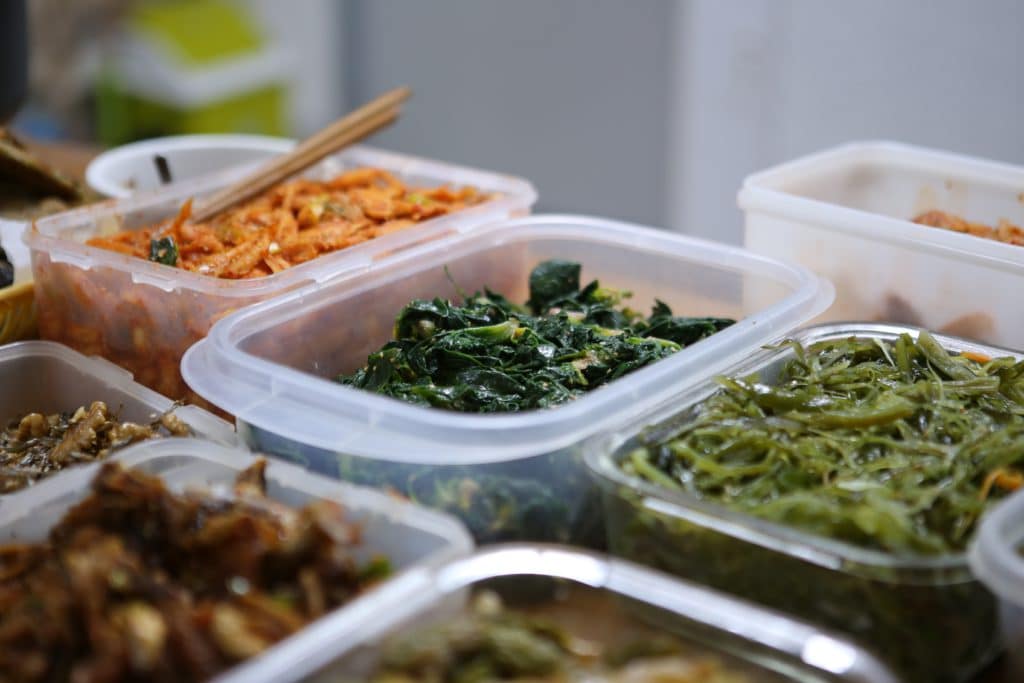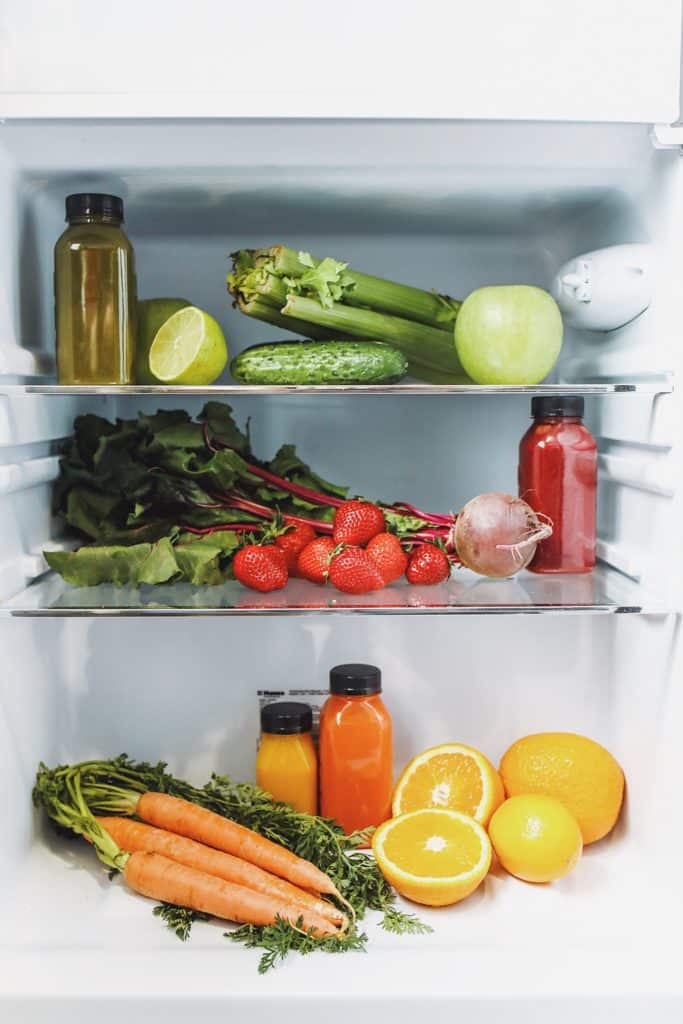
INTRO
What is a Veggie Challenge?

Veggies offer a ton of health benefits, making them a staple food in every household. The best part? There really isn’t a limit to how many veggies you should eat, just that you eat a diverse selection of them. So, we challenge you to try increasing your daily veggie intake by 1 or 2 cups!
Veggies can be eaten raw, cooked, or roasted, and can be added to a wide variety of dishes such as soups, stews, casseroles, and salads. There are also many different types of vegetables to choose from, each with its own unique flavor and nutritional profile, so there are endless possibilities for incorporating them into your diet.
Starting a veggie challenge with friends or coworkers is a fantastic way to create a habit of eating more vegetables and sharing new recipes, all while keeping each other motivated along the way.
Benefits of Vegetables
Nutrient-dense
Vegetables are rich in vitamins, minerals, fiber, and phytonutrients, which are essential for overall health and well-being.
Low in calories
Most vegetables are low in calories, making them an excellent food choice for weight management and weight loss.
Promote heart health
Many vegetables contain potassium, which can help lower blood pressure, reduce the risk of stroke, and improve heart health.
Support digestion
The fiber in vegetables can improve digestion, prevent constipation, and promote healthy bowel movements.
Support immune function
Vegetables contain vitamins and minerals that can help support immune function, helping to reduce the risk of infections and illnesses.
Reduce inflammation
Some vegetables, such as leafy greens, are rich in antioxidants and anti-inflammatory compounds that can help reduce inflammation in the body.
Protect against chronic diseases
The nutrients and phytochemicals in vegetables can help reduce the risk of chronic diseases, such as diabetes, cancer, and heart disease.
Eating More Veggies

There are a few key elements to consider when trying to eat more vegetables:
Variety. Try to incorporate a variety of vegetables into your diet, including different types and colors. Each type of vegetable has its own unique set of nutrients, so the more variety you can include, the better.
Accessibility. Make it easy for yourself to eat more vegetables by keeping them on hand and readily available. Keep a variety of pre-cut vegetables in the fridge, or freeze some to have on hand for quick and easy meals.
Preparation. How you prepare your vegetables can make a big difference in how much you enjoy them. Experiment with different cooking methods (such as roasting, grilling, or sautéing) and try out new seasonings and flavors.
Visibility. Keep your vegetables in plain sight in the kitchen or on the dining table. This can help remind you to incorporate them into your meals and snacks.
Planning. Plan your meals and snacks in advance to make sure you have enough vegetables to last the week. Consider meal prepping on the weekends to make it easier to incorporate vegetables into your meals during the week.

Sneaking Veggies in
Your veggie challenge doesn’t have to consist of eating salads for every meal. This can get boring, fast, which is why we’re here to tell you that there are a ton of ways to sneak more vegetables into your diet besides salads.
As a side dish
Serve veggies as a side dish with your main meals. This could include roasted or steamed veggies, or a vegetable salad.
In soups and stews
Add vegetables to soups and stews to boost the nutrient content and add flavor.
In smoothies
Add a serving of leafy greens (such as spinach or kale) or sulfur veggies (i.e. cauliflower) with some colorful fruits to your smoothies for a nutrient boost.
As a snack
Keep a supply of cut-up vegetables (such as carrots, bell peppers, and cucumbers) on hand for a healthy and convenient snack.
In sandwiches and wraps
Use lettuce, spinach, and other leafy greens to add nutrients and crunch to sandwiches and wraps.
As a topping
Top your gluten free pizza, pasta, or grain bowls with vegetables, or add veggies to your omelette for added nutrients and flavor.

How to Start a Veggie Challenge
Here are a few steps you can start to follow to build a habit of eating vegetables more regularly during your veggie challenge.
1
Start small
Don’t try to overhaul your diet all at once. Instead, start by adding a serving or two of vegetables to your meals each day and gradually increase from there.
2
Make it convenient
Keep a supply of pre-cut veggies in the fridge or freeze some for quick and easy meals. This will make it easier for you to incorporate veggies into your diet on a regular basis.
3
Experiment with different types and preparations
Try a variety of different veggies and prepare them in different ways (such as roasting, grilling, or sautéing) to find what you like best.
4
Incorporate vegetables into your favorite dishes
Find ways to add veggies to your favorite dishes, such as adding grated carrots to spaghetti sauce or diced bell peppers to omelets.
5
Be consistent
Make an effort to include veggies in your meals and snacks on a daily basis. Over time, this will become a habit.
6
Invite friends
Surround yourself with people who also prioritize eating vegetables, and invite friends, family, or coworkers to join your veggie challenge! This can help you stay motivated and on track with your goals.
Struggling to Eat Your Veggies?

Starting to eat more veggies might seem like a big ask. Our bodies get used to digesting certain nutritional compounds, so if lots of veggies aren’t part of your diet, you might notice some digestive changes and even some disgust to the new flavors.
But the good news is that once you start introducing different veggies into your diet during your veggie challenge, your body will actually start to crave these foods! Follow these steps to get your veggie challenge off to a good start:
Plan your meals and snacks in advance. Plan your meals and snacks in advance to make sure you have enough vegetables to last the week. Consider meal prepping on the weekends to make it easier to incorporate veggies into your meals during the week.
Get creative with recipes. Find new and interesting ways to prepare veggies, such as grilling, roasting, or adding them to soups and stews.
Eat veggies as a snack. Cut up some carrots, bell peppers, or cucumbers and keep them in a container in the fridge for a quick and healthy snack.
Don’t be afraid to try new things. Keep an open mind and try new vegetables and preparation methods. You may find a new favorite veggie that you enjoy eating.

Keep a variety of veggies on hand. Having a variety of vegetables available can make it more likely that you will find something you enjoy eating.
Make it a habit. Eating vegetables should become a regular part of your routine, like brushing your teeth or putting on your seatbelt. The more you do it, the easier it will become.
Level-up Your Veggie Consumption
Here are some tools and resources that can help you stay on track in your veggie challenge.
Nutritionist or dietitian. A nutritionist or dietitian can provide personalized guidance and support to help you increase your vegetable intake.
Online communities. There are many online communities, like the MasterHealth community, where you can connect with others who are also trying to eat more vegetables. Starting or joining a veggie challenge can be a great source of support and motivation.
Apps. There are several apps available, like MasterHealth, that can help you track your vegetable intake, and offer other support to help you eat more vegetables.
Support from friends and family. You can also enlist the help of your friends and family to support your goal of eating more vegetables by inviting them to join your veggie challenge. You could try cooking meals together and share veggie suggestions.
Health and wellness programs. Many workplaces and community centers offer health and wellness programs that can provide support and guidance for eating more vegetables.
Remember, it’s important to find a system that works for you and your needs. Don’t be afraid to try out different options until you find something that helps you successfully increase your vegetable intake.

Cooking Supplies for Veggies
There are many cooking tools and gadgets that can be used to make preparing and cooking vegetables easier and more enjoyable, including:
Mandoline slicer
This tool allows you to easily slice vegetables into thin, even slices. It can be especially helpful for making uniform cuts of vegetables for roasting or grilling.
Spiralizer
A spiralizer turns vegetables into spaghetti-like noodles, which can be a fun and creative way to incorporate more vegetables into your diet. Opt for zucchini noodles instead of standard spaghetti!
Grater
A grater is a simple but versatile tool that can be used to shred vegetables for salads, slaws, or coleslaw.
Immersion blender
An immersion blender is a handheld blender that can be used to puree vegetables into soups or sauces.
Steamer basket
A steamer basket is a simple but effective way to steam vegetables to retain their nutrients and flavor.
Salad spinner
A salad spinner is a useful tool for washing and drying leafy greens and other vegetables, making it easier to prepare salads and other dishes.
Overall, the key is to find cooking tools and gadgets that work for you and make it more enjoyable and rewarding to incorporate more vegetables into your diet.
Veggie FAQ's
The ideal cooking temperature for vegetables can vary depending on the type of vegetable and the desired level of doneness. Here are some general guidelines for common vegetables:
Leafy greens. Cook at medium-high heat (around 350°F to 375°F) until wilted or tender, usually for 2 to 5 minutes.
Root vegetables. Cook at medium heat (around 325°F to 375°F) until fork-tender, usually for 20 to 45 minutes.
Cruciferous vegetables (i.e. broccoli, cauliflower, and Brussels sprouts). Cook at medium-high heat (around 350°F to 375°F) until crisp-tender, usually for 5 to 10 minutes.
Beans and peas. Cook at medium heat (around 325°F to 375°F) until tender, usually for 20 to 45 minutes.
Squash and zucchini. Cook at medium-high heat (around 350°F to 375°F) until tender, usually for 5 to 10 minutes.
It’s important to note that these are general guidelines, and the cooking time and temperature can vary based on the specific vegetable and the method of cooking (such as roasting, steaming, sautéing, or grilling). It’s always a good idea to check for doneness by testing with a fork or knife.
Cooking frozen vegetables is easy and convenient. Here are some general steps you can follow to cook frozen vegetables.
Choose your cooking method. There are several ways to cook frozen vegetables, including boiling, steaming, microwaving, or sautéing. Choose the method that works best for your needs.
Preheat your cooking equipment. If you’re boiling or steaming your vegetables, preheat your pot of water or steamer. If you’re sautéing or stir-frying, preheat your skillet or wok.
Add the frozen vegetables to the cooking equipment. If you’re boiling or steaming, add the frozen vegetables to the pot or steamer basket. If you’re sautéing or stir-frying, add a small amount of oil or butter to the skillet or wok, then add the frozen vegetables.
Cook the vegetables. The cooking time will vary depending on the type of vegetable and the cooking method. As a general rule, frozen vegetables should be cooked for 5-10 minutes or until they are heated through and tender.
Season and serve. Once the vegetables are cooked, season them with salt, pepper, herbs, or spices as desired. Serve them hot as a side dish or use them as an ingredient in a recipe.
It’s important to note that some frozen vegetables, such as frozen spinach or corn, may release water as they cook. Drain off any excess water before seasoning and serving.
Sautéing vegetables is a quick and easy way to cook them while preserving their texture and flavor. Here are the steps to sauté vegetables:
- Choose your vegetables. You can sauté a variety of vegetables, such as onions, garlic, mushrooms, bell peppers, zucchini, broccoli, and carrots. Cut them into small, uniform pieces for even cooking.
- Heat the pan. Heat a large skillet or sauté pan over medium-high heat. Add a tablespoon or two of oil, such as olive oil or vegetable oil, and swirl it around to coat the bottom of the pan.
- Add the vegetables. When the oil is hot, add the vegetables to the pan. Stir them constantly to prevent them from sticking or burning.
- Season the vegetables. Sprinkle the vegetables with salt and pepper or other herbs and spices to taste.
- Cook the vegetables. Sauté the vegetables for 3-5 minutes, or until they are tender and lightly browned. Don’t overcook them, as they will become mushy.
- Serve the vegetables. Once the vegetables are cooked to your liking, remove them from the heat and serve them as a side dish, on top of a salad, or as a topping for pasta or rice.
That’s it! Sautéing vegetables is a simple and versatile cooking technique that you can use to create a variety of tasty and healthy meals.
Steaming vegetables is a healthy and simple way to cook the veggies while preserving their nutrients and natural flavors. This is probably one of the best ways to cook your veggies because you don’t need cooking oil, which can become oxidized with heat. In addition, the veggies are not in direct contact with the heat so you’re eliminating the harmful effects that burnt or charred food can have on your health.
Follow these steps to steam your vegetables:
Choose your vegetables. You can steam a variety of vegetables, such as broccoli, carrots, cauliflower, green beans, asparagus, and Brussels sprouts. Cut them into small, uniform pieces for even cooking.
Prepare the steamer. Fill a pot or a steamer basket with a few inches of water. Place the pot or basket over medium-high heat and bring the water to a simmer.
Add the vegetables. Place the vegetables in the steamer basket, making sure they are in a single layer and not overcrowded.
Cover and steam. Cover the pot or basket with a lid and steam the vegetables for 3-5 minutes, or until they are tender but still crisp. Don’t overcook them, as they will become mushy.
Check the vegetables. Pierce the vegetables with a fork or a knife to check if they are done. If they are still too firm, continue steaming for a few more minutes.
Serve and enjoy. Once the vegetables are cooked to your liking, remove them from the heat, add some salt and pepper and serve them as a side dish, on top of a salad, or as a filling for sandwiches or wraps.
That’s it! Steaming vegetables is a quick and easy cooking technique that you can use to enjoy a healthy and delicious meal with minimal effort.
If you don’t eat vegetables, you may be missing out on important nutrients that are essential for maintaining good health. Vegetables are rich in vitamins, minerals, fiber, and phytonutrients, which help to support a healthy immune system, protect against chronic diseases, and keep your body functioning properly.
Here are some potential consequences of not eating vegetables:
Nutrient deficiencies. Vegetables are a good source of many essential nutrients, such as vitamin C, vitamin A, folate, potassium, and dietary fiber. If you don’t eat enough vegetables, you may become deficient in these nutrients, which can lead to health problems over time.
Increased risk of chronic diseases. Eating a diet that is low in vegetables has been linked to an increased risk of chronic diseases such as heart disease, type 2 diabetes, and certain types of cancer.
Digestive problems. Vegetables are high in fiber, which is important for maintaining good digestive health. If you don’t eat enough vegetables, you may be at a higher risk of constipation, bloating, and other digestive problems.
Weakened immune system. Vegetables contain many nutrients that are important for a healthy immune system, such as vitamin C, vitamin A, and zinc. If you don’t eat enough vegetables, you may be more susceptible to infections and illnesses.
Weight gain. Vegetables are low in calories and high in fiber, which can help you feel full and satisfied. If you don’t eat enough vegetables, you may be more likely to overeat high-calorie foods, which can lead to weight gain and obesity.
In summary, not eating vegetables can have negative consequences for your health, so it’s important to include them as part of a balanced and healthy diet.










